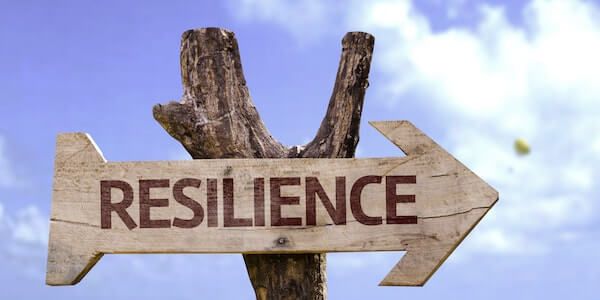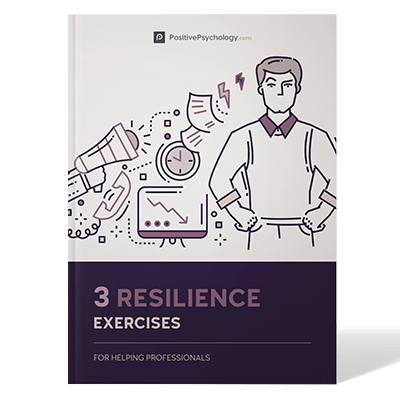

When we experience disaster, trauma, or distressing psychological issues, we usually react with grief and a range of negative emotions.
This is, of course, a natural reaction to having our hopes dashed or our goals thwarted. However, such experiences are not only an inevitable part of life but virtually required for growth and development.
Persistence and resilience only come from having been given the chance to work through difficult problems.
These are the exact sort of experiences that build resilience. With resilience, you can work through the effects of stress and negative emotions and not only bounce back, but actually thrive.
The U.S. Department of Health and Human Services (2015) defines individual resilience as the ability to withstand, adapt to, and recover from adversity and stress. In other words, resilience can manifest as maintaining or returning to one’s original state of mental health or wellbeing or reaching a more mature and well-developed state of mental health or wellbeing through the use of effective coping strategies.
In order to grasp and effectively develop resilience, it is critical to understand the factors contributing to resilience.
Before you read on, we thought you might like to download our three Resilience Exercises for free. These engaging, science-based exercises will help you to effectively deal with difficult circumstances and give you the tools to improve the resilience of your clients, students or employees..
Resilience is defined differently depending on who you ask; psychological researchers may have one working definition (or many!), while those who work directly with people who are struggling often see it differently.
There is no single accepted set of components of resilience, but this set of characteristics and contributing factors can provide a useful guide:
These components are not present in each and every measure of resilience, but they form a good basis for understanding the nature and scope of resilience. It should be easy to spot most of them in at least one of the eight resilience scales described below.
Seeing the many individual cogs that make up the resilience machine, it is easy to imagine that there are many different ways to define and measure resilience. Indeed, there are virtually countless ways that resilience has been described, and many different methods of measuring it.
The resilience scales below are all useful tools in providing a measure of resilience, but you will see that they are built on different theories, based on different components, and/or created for different populations. Depending on the context in which it will be applied, one resilience scale may be more appropriate than others.

With the importance of context and intended use in mind, we attempted to provide a diverse sample of resilience scales in the hopes that at least one of them may meet your needs.
While there are dozens of resilience measures out there for you to explore, we narrowed them down to the eight most popular and most empirically based resilience scales. These scales are listed and described below.
A study conducted by Windle, Bennett, & Noyes (2011) reviewed nineteen resilience measures. However, out of nineteen, only three of them received superior psychometric ratings, one of which is the Connor-Davidson Resilience Scale (CD-RISC).
This scale was originally developed by Connor-Davidson (2003) as a self-report measure of resilience within the Post Traumatic Stress Disorder (PTSD) clinical community (CD-RISC, n.d.). It is a validated and widely recognized scale with 2, 10, and 25 items which measure resilience as a function of five interrelated components:
With an extensive number of studies using this tool, conducted within a varied range of populations, the CD-RISC is considered one of the higher scoring scales in the psychometric evaluation of resilience (Windle, Bennett, & Noyes, 2011).
The RSA, another resilience scale rated highly by Windle, Bennett, & Noyes (2011), was authored by Friborg et al. (2003) as a self-report scale targeting adults. It is recommended for use in the health and clinical psychology population.
This scale has five scoring items that examine both the intrapersonal and interpersonal protective factors that promote adaptation to adversity.
The authors, Friborg et al. (2003), noted the key factors which contribute to highly resilient individuals, namely family support and cohesion, external support systems, and dispositional attitudes and behaviors, which the scale items are founded on. They are:
A later study performed by Friborg et al. (2005) used the RSA to measure the relationship between personality, intelligence, and resilience. They found many links between personality and resilience factors, such as the connection between higher personal competence and elevated emotional stability. There were, however, no significant findings related to cognitive ability (Friborg et al., 2005).
This is in line with Windle et al. (2011), who concluded that the RSA is highly useful for assessing the protective factors which inhibit or provide a buffer against psychological disorders.
While most resilience assessments look into the factors which develop resilience, The Brief Resilience Scale (BRS) is a self-rating questionnaire aimed at measuring an individuals’ ability to “bounce back from stress”. This instrument, developed by Smith et al. (2008), has not been used in the clinical population; however, it could provide some key insights for individuals with health-related stress (Smith, et al., 2008).
Amat et al. (2014) explain that the BRS instrument consists of six items, three positively worded items, and three negatively worded items. All six relate to the individual’s ability to bounce back from adversity. The scale’s development controlled for protective factors such as social support in order to get a reliable resilience measure (Smith, et al., 2008).
This is the third and final resilience measure noted by Windle et al. (2011) as a highly valid and reliable measure of resilience, but there are many more with evidence to back their effectiveness.
This scale is the oldest scale on our list but is still in use by many researchers. The Resilience Scale, developed by Wagnild and Young in 1993, was created and validated with a sample of older adults (aged 53 to 95 years). This scale consists of 25 items and the results have been found to positively correlate with physical health, morale, and life satisfaction, while negatively correlating with depression.
The scale is intended to measure resilience based on five essential characteristics:
These five characteristics are assessed using two subscales, the 17-item Personal Competence subscale and the 8-item Acceptance of Self and Life subscale.
Subsequent validation of the scale in 2009 by Wagnild reaffirmed its internal consistency and construct validity, supporting its continued effectiveness as a tool for the assessment of resilience.
In addition to the original 25-item scale, there is a shortened 14-item scale that has also proven to be valid and reliable in measuring resilience (Abiola & Udofia, 2011).
The Scale of Protective Factors (SPF) was developed by Ponce-Garcia, Madwell, and Kennison in 2015 to capture a comprehensive measurement of resilience. The authors tested and validated this resilience scale in a sample of nearly 1,000 college students, and found the SPF to be a valid and reliable measure of resilience for measuring resilience, especially in groups identified as survivors of violent trauma.
This scale measures resilience in a slightly different way than the previously mentioned scales. It focuses on the factors that combine to create a buffer between individuals who have experienced trauma and the stress and disruption to functioning that can follow, rather the components that constitute resilience directly.
It consists of 24 items measuring two social-interpersonal factors ( and ) and two cognitive-individual factors ( and ).
The SPF has since been validated in a review of resilience scales by Madewell and Ponce-Garcia (2016), providing evidence of its validity and effectiveness in clinical use.
The Predictive 6-Factor Resilience Scale was developed based on the neurobiological underpinnings of resilience and the theorized relationship with health hygiene factors (Roussouw & Roussouw, 2016).
The PR6 measures resilience as a function of six domains concerning several interrelated concepts:
The PR6 was found to have good internal consistency and correlate with other measures of resilience as well as health hygiene scores.
Based on these results, the PR6 can be considered an effective measurement and a particularly good assessment for use in improving resilience.
This scale was developed by Block and Kremen in 1996 for use in measuring resilience in non-psychiatric contexts. While the authors term their construct “ego resiliency,” it is basically resilience as we know it viewed in terms of adaptability to changes in one’s circumstances.
The Resilience Scale (RS-14) consists of 14 items rated on a scale from 1 = does not apply to 4 = applies very strongly, with higher scores indicating higher levels of resilience.
Scores on this scale have been found to positively correlate with intelligence as it relates to the ability to adapt, supporting the scale’s ability to assess an individual’s ability to bounce back from failure and disappointment.
Finally, the Academic Resilience Scale (ARS-30) is a recently developed measure used to assess resilience in a particular context: academic success. Simon Cassidy (2016) describes academic resilience as the tendency to persevere and succeed in education despite meeting with adversity. It is a multi-dimensional construct focusing on both cognitive affective and behavioral responses to academic adversity.
The ARS-30 is based on responses to a vignette describing a significant academic challenge, rated on a scale from 1 = likely to 5 = unlikely.
The items in this scale fall into one of three factors:
High scores on factors 1 and 2 and low scores on factor 3 indicate high resilience.
This scale was found to be highly internally reliable, and scores correlated significantly with a measure of academic self-efficacy. While the ARS-30 is most appropriate in academic contexts, scores can be useful in other situations as well.

“As a leader, apologize for making mistakes. Don’t apologize for making decisions.”
Resilience is an important characteristic in the context of work. Nobody is a consistently perfect employee, and everybody will at some point receive critical feedback or experience a failure at work.
This fact of life highlights the role of resilience in the workplace, as a means for employees to recognize where they have failed or come up short, identify the most constructive ways to move forward, and bounce back with vigor and enthusiasm to get it right the next time.
In addition to the stereotypical experiences that require resilience to survive, resilience is integral in other, less obvious situations as well – we often need to be resilient even in the face of positive changes! Increased responsibility, forward progress, and significant positive events can all result in the need for adaptation and recovery (Youssef & Luthans, 2007).
However, it is usually the responses to negative change that highlight the need for resilience.
In the workplace, a lack of resilience can manifest itself in many ways – the fear of presenting in front of an audience, the frustration after receiving criticism for one’s work, the guilt about not spending enough time with one’s family, the embarrassment one feels after a meeting that didn’t go well.
In the book The Resilience Factor, Karen Reivich and Andrew Shatté (2002) identify the five typical emotions that are associated with a lack of resilience, namely;
Of course, these emotions are completely natural to experience from time to time. The key to recognizing these emotions as indicators of a lack of resilience is whether they are disproportionate to the event (looking back you might catch yourself thinking “that was over the top!”), or if the same event triggers the same emotion repeatedly.
For those who identify with this description, an increase in resilience would be hugely beneficial.
In the workplace, a lack of resilience can become an issue when it prevents you from developing your skills and interacting effectively with others. For example, a fear of public speaking may lead you to remain silent even when you know you have something to contribute to a discussion. Another example is if you become defensive when receiving negative feedback, losing the opportunity to learn and develop your skills.
In short, a lack of resilience can have an immediate impact on motivation, cognitive functioning, and emotional wellbeing. In cases of a serious lack of resilience, it leads to helplessness and seeing oneself as a victim of circumstance.
Conversely, we all know people who immediately pick themselves up and dust themselves off after a setback, regardless of what stressors and tragedies life throws at them. In general, resilience is defined as the ability to bounce back from adversity, and resilient people practice resilience by assessing and exploring all of their options before taking action. These tendencies make it unlikely that they repeat unhelpful past experiences.
For us to flourish and thrive at work (and at home, for that matter) we need to ensure we recognize those emotions as they arise, assess whether they are appropriate, take responsibility for our lack of resilience, if that is the case, and apply the tools to reframe our experiences.

For organizations, it is extremely important to understand the indicators of a lack of resilience and teach leaders and employees how to respond to difficult situations in order to increase their resilience.
Four of the most important reasons why organizations should understand the contributors of resilience and start introducing programs which build resilience are:
While organizations can work to address workload issues in parallel, resilience skills directly benefit employees’ psychological wellbeing by helping them reframe their perception of stress. Healthy and happy employees are productive employees, making employee wellbeing an important consideration for every organization.
Employees looking to grow and develop their skills will benefit from learning to cope with adverse work situations, such as negative feedback. Managers who understand the dynamics of resilience can coach their employees much more effectively.
Research has shown that people (and women in particular) who tend to attribute their failures to personal shortcomings are at risk of diminishing self-confidence, a problem that can be addressed through the development of resilience skills.
Most companies need to innovate on an ongoing basis to survive in this business climate. This means that employees need to work constantly on maintaining and upgrading their capabilities. This can be hampered by the so-called learning curve – essentially the experience of a dip in skill and motivation as individuals learn to apply a new skill. This can be frustrating and possibly lead to stagnation if the new skills are not applied successfully.
Managers who recognize that their employees are displaying signs of “non-resilience” during this learning curve (rather than interpreting the same behavior as non-cooperation, for example) can jump right in and begin providing the appropriate support, thus ensuring effective learning and laying the groundwork for successful innovation.
A lack of resilience often becomes apparent in our interpersonal situations. By understanding typical behaviors linked to a lack of resilience, leaders can encourage employees to examine their thinking patterns and change their interpretation of the situation, thereby reducing negative feelings between team members and improving team dynamics.
In short, resilient employees are simply better employees, on average. They meet their challenges in different ways, develop and maintain better buffers against stress and anxiety, and more effectively recover from the setbacks that everyone experiences from time to time.
Paula Davis-Laack (2014), a positive psychologist who has applied her knowledge and skills to the practice enhancing resilience in thousands of working professionals, lays out the seven ways that resilient employees do things differently, benefitting both themselves and their organization.
Highly resilient employees:
Any leader would agree that these seven capabilities are extremely desirable in employees. These are the employees that produce high-quality work, innovate, and spread their inspiration and motivation to their colleagues.
Luckily for leaders everywhere, resilience is a characteristic that can be built, developed, and enhanced in any workforce (Youssef & Luthans, 2007).

The Positive Psychology Toolkit© is a groundbreaking practitioner resource containing over 500 science-based exercises, activities, interventions, questionnaires, and assessments created by experts using the latest positive psychology research.
Updated monthly. 100% Science-based.
“The best positive psychology resource out there!”
— Emiliya Zhivotovskaya, Flourishing Center CEO
To quote renowned positive psychologist Mihaly Csikszentmihalyi (2002, p.200):
“The ability to take misfortune and make something good come of it is a rare gift. Those who possess it (…) are said to have resilience or courage.”
While some people certainly seem to be born with the resilience gene, some of the necessary skills of resilience can also be learned when practiced over time.
There are a number of useful models and tools that offer frames for understanding and building resilience. The following three models address the topic of resilience from various angles and can provide useful insights.

Briefly described by Seligman (2012) and addressed in detail in Reivich and Shatté (2002), this model explains how the five key negative emotions mentioned earlier in this article are linked to specific experiences. Feeling angry is usually linked to the perceived violation of one’s rights. Feeling embarrassed is usually the result of an unfavorable social comparison. Sadness and depression are often linked to the loss of self-worth.
These 5 specific steps introduced in this ABCDE model offer the keys to building resilience:
This model by German psychotherapist Micheline Rampe (2010) is useful for understanding the key steps that need to be taken by an individual on their journey to resilience. Many of the strategies described by Rampe (2010) are compatible with approaches recommended in positive psychology literature.
These 7 pillars are:
These pillars offer key steps that give an individual the tools for dealing with adversity in a positive and constructive way.
It should be noted that in the absence of real, objective reasons that things are going to be better, hope and optimism can be counter-productive. Without subsequent improvement in circumstances, there is a good chance that unrealistic hope and optimism will lead to disappointment.
If nothing changes about your situation or your course of action, how can you expect things to be different in the future? This is called “big optimism” and or false hope, and it should not be encouraged in those who are not naturally highly optimistic.

These detailed, science-based exercises will equip you or your clients to recover from personal challenges and turn setbacks into opportunities for growth.